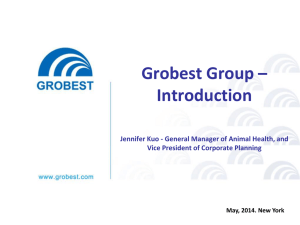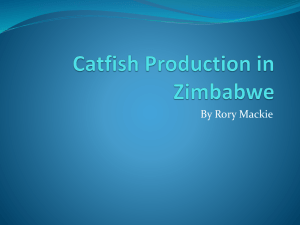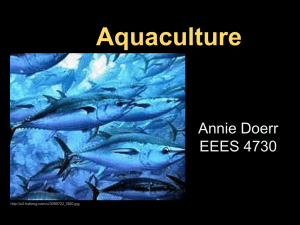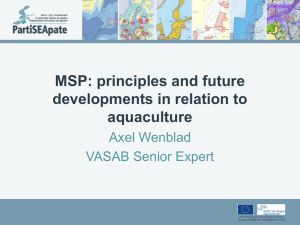Lysbilde 1
advertisement
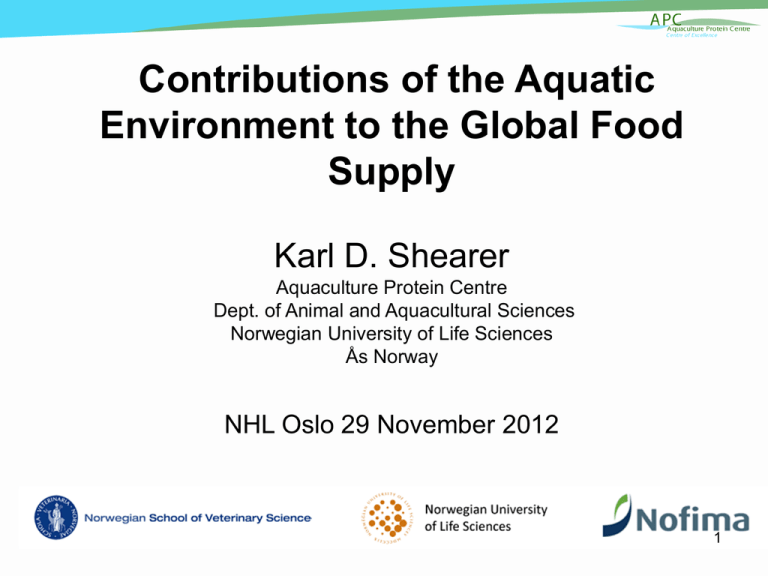
Contributions of the Aquatic Environment to the Global Food Supply Karl D. Shearer Aquaculture Protein Centre Dept. of Animal and Aquacultural Sciences Norwegian University of Life Sciences Ås Norway NHL Oslo 29 November 2012 1 Three Questions from Stein Ove Østvik 1. The contribution of marine protein to the global food supply 2. The benefits of consuming marine proteins 3. Economic opportunities for marine proteins 2 1 The contribution of seafood to global food supply 3 The Current Global Food Situation 4 Human Food Requirements for Energy and Protein Average per Person Energy 2500 kcal/day Protein 55 g Johansson et al., AMBIO (2010) 5 Global Requirements for Energy and Protein Annual needs of 6.7 billion people in 2010 Energy 7092 TWh Protein 134 Mt Johansson et al., AMBIO (2010) 6 Global Food Energy Budget Parameter Energy (TWh) Gross energy 19900 Seeds -700 Lost -1300 Mould -2700 Discarded Inedible Feed (oil crop) -360 -1770 -690 Feed (peas & cereal) -4545 Livestock 1183 Game, fish &seafood Net Energy 217 9265 Johansson et al., AMBIO (2010) 7 Human Food Energy Need vs. Supply Region Population (109) World 6.7 (2010) EU27 0.50 (2010) Demand (TWh) 7092 526 Available (TWh) 9265 431 In 2010 we could feed 8.7 billion 8 Johansson et al., AMBIO (2010) We can conclude that, at present, we have enough food to feed the global population. Malnutrition (one billion people) is due to poverty. 9 FAO Global Food Price Index Lagi et al., 2011 10 Future Food Demand and Supply 11 Increasing Food Demand The Food and Agriculture Organization (FAO) projects that a 70% increase in the food supply will be required by 2050 Due to an increase in population and an increase in meat consumption 12 13 Human Food Energy Demand Region Population (109) Demand (TWh) Available (TWh) World World 7092 10690 9265 + 15% 6.7 (2010) 10.1 (2100) +51% Johansson et al., AMBIO (in Press) 14 Where does our food come from? 15 Ecosystems and Trophic Levels Terrestrial Aquatic Microbes Carnivores Bacteria Yeast Herbivores, Omnivores Carnivores Herbivores, Omnivores Plants Sun, Water, Soil, Nutrients Sun, Nutrients 16 Terrestrial Crop Production Herbivores, Omnivores Plants Sun, Water, Soil, Nutrients Global Crop Production 2010 FAO Food Outlook, Nov 2012 18 Limits to Terrestrial Plant Production Arable land is limited Topsoil loss Water is limited Phosphorus and potash Salinization 19 Terrestrial Meat Production Terrestrial Carnivores are missing Herbivores, Omnivores Plants Sun, Water, Soil, Nutrients Global Meat Production 2010 FAO Food Outlook, Nov 2012 Global Meat Production 19602010 22 Limits to Terrestrial Animal Production Feed costs Ethical considerations 23 Aquatic Plant Production Carnivores Herbivores, Omnivores Sun, Nutrients 24 Wild Aquatic Plant Harvest Harvest of aquatic plants is about 3.5 Mt wet weight The majority is consumed directly 25 Aquatic Meat Production Carnivores Herbivores, Omnivores Sun, Nutrients 26 Global Fish Production 27 Trends Growth in Global Fish Production Aquaculture 19811990 19912000 Capture 20012010 20112020 28 Limits to Harvest of Wild Marine Resources Over fishing Climate change Pollution Ocean acidification Introduced species 29 Aquaculture 30 Aquaculture Carnivores Herbivores, Omnivores Sun, Nutrients 31 Global Aquaculture Production 2009 Total = 73 Mt FAO, 2011 32 Classification of Aquaculture Trophic level Degree of Control Plants Extensive Herbivore Extensive Omnivore Semi-intensive Carnivore Intensive Concentrated Aquatic Animal Feeding Operation (CAAFO) 33 Global Aquaculture Production 2009 Group Production (Mt) Value (US$ billion) Value ($ per kg) Freshwater fishes 30.64 44.19 1.44 Diadromous fishes 3.53 14.00 3.96 Marine fishes 1.95 7.10 3.64 Crustaceans 5.30 24.13 4.55 Molluscs 13.52 13.13 0.97 Miscellaneous aquatic animals Aquatic plants 0.73 2.75 3.77 17.34 4.82 0.28 Total aquaculture production 73.02 110.12 1.51 FAO 2011 34 2 The benefits of consuming marine proteins 35 Seafood and Human Health The benefits and risks of seafood consumption are examined: 1. Measuring the levels of nutrients and known risk factors 2. In a clinical trial (short term, variables, mechanisms)) 3. An epidemiological study (long term, associations) 36 Measuring Seafood Composition NIFES National Institute of Nutrition and Seafood Research Nutrient Composition of Seafood Undesirable Substances 37 Clinical trial An Example (A) Increased Omega-3 intake reduces (B) Blood triglycerides (B) Reducing triglycerides improves (C) Cardiovascular health Therefore (A) Increased Omega-3 intake improves (C) cardiovascular health 38 Clinical Trial (A) Increased Omega-3 intake reduces (B) Blood triglycerides (B) Reducing triglycerides may improve (C) Cardiovascular health Therefore (A) Increased Omega-3 intake may improve (C) Cardiovascular health Rizos, E. C. et al., Association Between Omega-3 Fatty Acid Supplementation and Risk of Major Cardiovascular Disease Events: A systematic Review and Meta-Analysis. Sept 2012. 308 (10) 1024-1033. No reduction in cardiovascular outcomes and omega-3 supplementation 39 Clinical Trials Correlation vs. Causation We need to understand the mechanisms e.g. How do omega-3s affect cardiovascular health? 40 Epidemiological Study Searching for correlations Between variables 41 Chowdhury, R. et al. BMJ 2012; 345 Association between fish consumption, long chain omega 3 fatty acids, and risk of cerebrovascular disease: systematic review and meta-analysis Meta-analysis 38 studies 794,000 people People consumed fish 0 or 1 times/week 2-4 times/week 5 or more times/week 42 Input Variables A1, A2, A3 A1 A2 A3 43 Statistics Examine the correlation between the input variables A1, A2, A3 and the response in Variable C (Incidence of stroke) 44 Results of the Analysis The were a total of 34817 strokes (C) A3 Fish 0-1 times/week 12057 strokes A2 Fish 2-4 11334 -6% A1 Fish 5 or more 10610 -12% 34817 45 Conclusion Eating fish reduces strokes Control 46 Correlation vs Causation 47 The Alternative Explanation A1 A2 A3 Control 48 Seafood and Human Health Contaminant free seafood is a good source of nutrients, but many studies examining the benefits or risks of consuming seafood have flaws and that additional studies are required. 49 The Salt Scare of the 90’s 50 3 Opportunities associated with seafood 51 Wild Harvest It is unlikely that the total wild harvest will increase significantly 52 Aquaculture Opportunities 53 Extensive Aquaculture Production (Mt) 2009 This is as close as we can get to a free lunch 54 Intensive & Semi-intensive Aquaculture Production (Mt) 2009 55 Concentrated Aquatic Animal Feeding Operations Animal production, both terrestrial and aquatic, is moving, increasingly, toward concentrated feeding operations CAFOs and CAAFOs 56 Global Compound Feed Production 57 Compound Feed by Species 58 Salmon Feed Until recently, was composed primarily of things people did not eat. But now We are feeding fish human food. 59 Plant Protein and Oil in Norwegian Salmon Feeds Torrissen et al. 2011 60 Atlantic Salmon Feed in Norway This would require (as plant ingredients) 270,000 t wheat (United States) = 75,000 ha 1,560,000 t soy (Brazil) = 675,000 ha 950,000 t canola (Europe) = 320,000 ha 2,780000 t 1,070,000 ha Torrissen et al. 2011 Nutrient Composition of Norwegian Salmon Feed Component Feed Mass (tons) 1,137,120 Protein (tons) 460,850 EPA+DHA (kg) 49,373 Phosphorus (tons) 12,046 (Ytrestøyl et al., 2011) 62 Norwegian Atlantic Salmon Nutrient Budget Component Feed Fillet % Retained in fillet Mass (tons) 1,236,000 612,097 49% (16%)* Energy (MJ) 31,000 6,646 21% Protein (tons) 460,850 121,807 26% 12,909 26% EPA+DHA (kg) 49,373 * Dry basis (Ytrestøyl et al., 2011) 63 Food In : Food Out 1 kg feed 550 g fillet = 450 g protein 110 g protein 64 Aquaculture and Human Protein Needs Feeding Norwegian Salmon for 1 Year Protein in the feed could supply 19.5 million people for 1 year Protein recovered Protein lost can supply 4.9 million people for 1 year could supply 14.6 million people for 1 year 65 Price ($/lb) of Seafood in Seattle $ 0.88 $ 4.49 $ 5.997.99 $ 3.39 $ 3.99 $ 4.99 $ 5.99 $ 8.99 66 Price (NOK/kg) of Seafood in Seattle 12.0 61.4 81.9109 46.3 54.5 68.3 81.9 ($1 = 5.7 NOK) 123 67 Palanco, F. et al., 2012. Globfish Research Program #106. FAO 68 Ethical Issues “The rich will consume the high quality protein and the poor will eat lower quality protein because that is all they can afford.” Jorgen Randers 69 Aquaculture Has the potential to increase significantly Feed cost, disease and escapement are major issues Recirculation systems will increase Seafood must compete with with terrestrial meat in price Meat consumption my become an ethical issue 70 Summary The human food supply is comprised mainly of terrestrial plants Plant production is becoming constrained by limited natural resources Demand for animal protein is increasing due to population increase and changes in diet preferences Meat production, both terrestrial and aquatic, rely on terrestrial feed ingredients Meat production has a large negative impact on the total food supply 71
